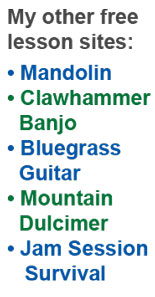| FREE
BANJO LESSONS - by Bradley Laird

LESSON
5
Tuning to a Guitar
If you have an "in tune" guitar nearby you can tune your
banjo to the guitar. (It is a good idea to purchase an in-tune guitar
player so that you have someone to play backup for you and drive your
tour bus.) Three strings on the guitar are exact pitch matches to strings
on your banjo. Here they are:

In other words,
the 2nd, 3rd, and 4th strings of both instruments are tuned to the same
pitches. Once you have matched those strings
you need to tune your 1st
and 5th strings.
To tune the 1st string, have your guitar player fret his 2nd string
at the 3rd fret. This makes a D note and you match your 1st
string to that pitch.
If he
refuses to cooperate you can do the same thing on your banjo since you
have already tuned your 2nd string. Just hold a finger just
behind the 3rd fret
of your 2nd
string and play the note. Match your first string to this note.
To tune your 5th string, have the guitar player fret his 1st string
at the 3rd fret. This is a high G note and you tune your 5th
string to match
that
pitch.
You can also, fret your 1st string at the 5th fret and match your 5th
string to that note.
Checking Your Tuning
When you are done tuning, using any of the above methods, you can
verify that your tuning is correct by playing the following notes:

Note:
If the bridge is not located in the correct place on the head, your
fretted notes will not sound in tune no matter what
you do. In my downloadable Banjo Instruction Course I include a section which teaches banjo
maintenance and setup you will learn how to correct this and other problems.
Continue to Lesson 6.
All of my banjo books are downloadable eBooks. Get 'em today!
Free DHTML scripts provided
by
Dynamic Drive
|




